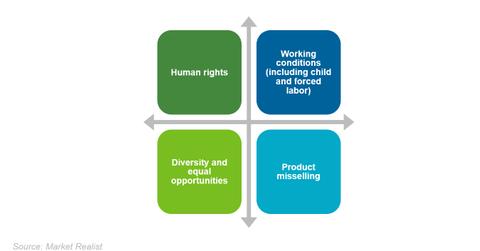What Social Factors Do ESG Criteria Touch On?
Some issues considered under the social criterion when evaluating a company’s products and practices are human rights, human capital management, and work conditions.
Nov. 1 2016, Updated 5:04 p.m. ET

ESG criteria
Earlier in this series, we noted that socially responsible investing is done on the basis of environmental, social, and governance (or ESG) criteria. Analysts look at the operations of a company from these three perspectives to evaluate its standing among its peers. Given their mandate, analysts use different strategies to invest in companies when making use of ESG criteria.
It’s important to note that a given issue cannot be strictly classified as either environmental, social, or governance-related. In the previous article, we looked into environmental issues. Let’s turn our attention to social issues.
Social issues
Some issues considered under the social criterion when evaluating a company’s products and practices are:
- human rights
- human capital management
- work conditions (including child labor and forced labor)
- diversity and equal opportunities
- employee attraction and retention
- customer satisfaction
- product misselling
- product safety and liability
Some of the above social issues have been highlighted by the CFA Institute, while some others have been highlighted by the Principles for Responsible Investment.
Among examples of companies dealing with social issues are Apple (AAPL), which was blamed for its harsh assembly plant conditions in China in 2012. Also in 2012, Walmart (WMT) was blacklisted by a pension fund due to its poor labor practices. Meanwhile, The Gap (GPS) has come under scrutiny for child labor.
Among the ETFs that invest on this theme are the Workplace Equality ETF (EQLT) and the SPDR SSGA Gender Diversity ETF (SHE).
From social issues, let’s move on to the last of the ESG criteria: governance.
